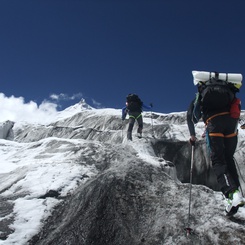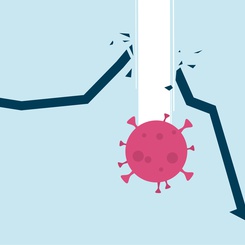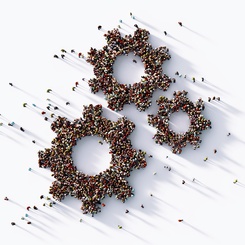In her article Annick Ancelin-Bourguignon, Professor of Management at ESSEC Business School, explores the topic of daily creativity at work. Great source of meaning for employees, creativity is profitable not only for them but also for the organization. However though, for creativity to exist and thrive one must not try to manage it.
Are All Workers Rebels?
First things first, let us start with the difference between prescribed work and real work. Prescribed work, that is to say tasks, refers to all that is predefined by the employer and given to the worker to organize and realize: local objectives, procedures and expected working methods, written and oral instructions, security rules, machines and other devices, time constraints, work organization etc. In contrast, real work refers to what workers “really” do, also called activity and it deviates from prescribed tasks for many reasons. For example, devices and other resources may turn out to be less effective than expected; workers might need to adjust activity to changes in their inner emotional and psychological state; procedures may fail to consider environmental constraints, etc. The gap between prescribed work and real work does not mean that workers are rebels who do otherwise than prescribed; it means that work contains an irreducibly part of creation and can never be reduced to predefined plans and prescriptions.
Mètis or Effectiveness First!
The “matter” filling the gap between prescribed and real work is called daily creativity, or “inventive intelligence”. It is linked to the Greek concept of “Mètis”. Mètis refers to the way animals cunningly simulate death to discourage predators, to David’s craftiness facing Goliath or to general “tricks of the trade” that save effort. It is concerned with effectiveness to the detriment of established rules. Childminders, for example, must watch over many infants sleeping after lunch. To avoid falling asleep, they have found a tip. They knit. This kind of know-how is generally kept discreet, if not secret, because it is very unlikely that superiors would understand the reasons pushing employees to knit during working hours. Daily creativity is indeed most often invisible because it deviates from prescription and as such might be reprimanded by hierarchy, but also, it is a way to protect personal “tricks” from being incorporated into prescription.
From Spoons to Google Docs… You Name It!
Some of us use a spoon to open a difficult jam jar. We place a chair in front of a door to prevent it from closing. This is called catachresis, which means using a tool for another use than the established one. Such uses are creative in that they divert objects from the usage for which they have been designed. In work-related situations, catachresis is the creative way to be more efficient or more comfortable at work.
But catachrestic creativity can be extended to apps such as Google Docs®. Google Docs® enables people at a distance to work simultaneously on the same text. However, other uses are often reported by IT experts. Google Docs® is notably used in meetings where it enables a group of people to discreetly share perceptions and drive collective behavior while keeping the other group fully ignorant of such exchanges. The same device allows an executive manager to communicate with team members, sometimes quite far away, to collect additional information or elaborate new pieces of argumentation in real time. Besides improving performance, the participants’ subjective experience of pleasure and play that arises from the creative practice is key.
Even though all these creative practices participate in the process of improving performance and contribute to well-being at work, they emerge without any organizational demand; they result from workers’ individual will to be more efficient (sometimes more comfortable) in their daily work. And even if changes are often incremental (even invisible), they can make a huge difference in terms of individual well-being and performance.
Treating Performance as Consequence, Not an Objective
There are many positive emotions associated with daily creativity: relief (of finding a solution to an external issue or releasing an internal tension), pride, sense and meaning of work, self- satisfaction, engagement, etc. Given its benefits, managing daily creativity is tempting. Thus, every worker would feel urged to suggest innovation in work processes and evaluate proposals, with possible consequences on recognition, compensation and/or career. Unfortunately, this would simply kill the benefits. Positive emotions are the direct outcome of the spontaneity and autonomy of the creative process. When creativity is on demand, the worker may be happy to have brought an answer but it is the mere satisfaction of having met the objective and the demand. Though creativity should not be controlled, which doesn’t mean that there isn’t any control on compliance with internal and external rules, managers still have the means to foster an environment where natural, spontaneous daily creativity can bloom.
The Person, Not the Outcome, Not the Process, Is the Core of Management Methods
To bloom daily creativity needs an environment recognizing the complexity and the creative potential of any worker: autonomy, freedom of developing thoughts about his or her work and above all, right to make mistakes. It has been established that trials and errors are part of the conditions fostering creativity. However, except in R&D departments where this is the rule of the game, the right to make mistakes is something hardly acceptable in the great majority of companies. The pressure on outcome put on workers by the various performance systems does not only induce reward expectations but also punishment threats, thus dampening any motivation of trying new paths.
Furthermore, companies could consider leaving room for organizational arrangements that offer possibilities for collective debates about work. Such meetings could become the new place to share one’s creative tips, to freely discuss the relevance of changing work methods and practices, etc.
Performance Relies on Individual Creativity
Between work expectations and reality constraints, there is an ineluctable need to be creative. Performance relies on individual creativity. This creativity is a source of meaning at work and generates implication which makes it extremely valuable for company performance. Daily creativity cannot arise on demand, and the only way to encourage it is precisely by leaving it be. And this might turn out to be quite frustrating for managers, afraid to lose control over the organization.
Even though conditions and forms of actualization of daily creativity may vary across cultures and societies, the concept of daily creativity at work is universal. Everybody is potentially creative since creativity is “inherent to life itself*”.
*Winnicott, D. (1971). Playing and Reality. London: Tavistock,
−−−









